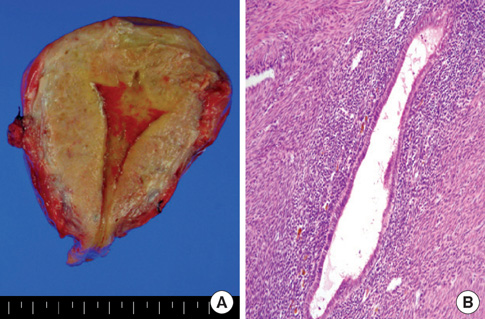J Korean Med Sci.
2010 Sep;25(9):1372-1374. 10.3346/jkms.2010.25.9.1372.
Acute Kidney Injury due to Menstruation-related Disseminated Intravascular Coagulation in an Adenomyosis Patient: A Case Report
- Affiliations
-
- 1Department of Internal Medicine, Pusan National University School of Medicine, Busan, Korea. dongwonlee@pusan.ac.kr
- 2Division of Nephrology, Department of Internal Medicine, Pusan National University School of Medicine, Busan, Korea.
- 3Division of Infectious Disease, Department of Obstetrics and Gynecology, Pusan National University School of Medicine, Busan, Korea.
- 4Medical Research Institute, Pusan National University School of Medicine, Busan, Korea.
- KMID: 1785920
- DOI: http://doi.org/10.3346/jkms.2010.25.9.1372
Abstract
- The authors report a case of acute kidney injury (AKI) resulting from menstruation-related disseminated intravascular coagulation (DIC) in an adenomyosis patient. A 40-yr-old woman who had received gonadotropin for ovulation induction therapy presented with anuria and an elevated serum creatinine level. Her medical history showed primary infertility with diffuse adenomyosis. On admission, her pregnancy test was negative and her menstrual cycle had started 1 day previously. Laboratory data were consistent with DIC, and it was believed to be related to myometrial injury resulting from heavy intramyometrial menstrual flow. Gonadotropin is considered to play an important role in the development of fulminant DIC. This rare case suggests that physicians should be aware that gonadotropin may provoke fulminant DIC in women with adenomyosis.
Keyword
MeSH Terms
-
Acute Kidney Injury/*diagnosis/etiology
Adult
Creatinine/blood
Disseminated Intravascular Coagulation/*chemically induced/complications
Endometriosis/*complications/diagnosis/surgery
Female
Fertilization in Vitro
Gonadotropins/*adverse effects
Humans
Magnetic Resonance Imaging
Menstruation/*physiology
Uterus/pathology/surgery
Figure
Reference
-
1. Taylor FB Jr, Toh CH, Hoots WK, Wada H, Levi M. Scientific Subcommittee on Disseminated Intravascular Coagulation (DIC) of the International Society of Thrombosis and Haemostasis (ISTH). Towards definition, clinical and laboratory criteria, and scoring system for disseminated intravascular coagulation. Thromb Haemost. 2001. 86:1327–1330.2. Nakamura Y, Kawamura N, Ishiko O, Ogita S. Acute disseminated intravascular coagulation developed during menstruation in an adenomyosis patient. Arch Gynecol Obstet. 2002. 267:110–112.
Article3. Azziz R. Adenomyosis: current perspectives. Obstet Gynecol Clin North Am. 1989. 16:221–235.4. Noe M, Kunz G, Herbertz M, Mall G, Leyendecker G. The cyclic pattern of immunohistochemical expression of oestrogen and progesterone receptors in human myometrial and endometrial layers: characterization of the endometrial-subendometrial unit. Hum Reprod. 1999. 14:190–197.5. Leyendecker G, Herbertz M, Kunz G, Mall G. Endometriosis results from the dislocation of basal endometrium. Hum Reprod. 2002. 17:2725–2736.
Article6. Drake TA, Morrissey JH, Edgington TS. Selective cellular expression of tissue factor in human tissues. Am J Pathol. 1989. 134:1087–1097.7. Lockwood CJ, Nemerson Y, Krikun G, Hausknecht V, Markiewicz L, Alvarez M, Guller S, Schatz F. Steroid-modulated stromal cell tissue factor expression: a model for the regulation of endometrial hemostasis and menstruation. J Clin Endocrinol Metab. 1993. 77:1014–1019.
Article8. Reinhold C, Tafazoli F, Mehio A, Wang L, Atri M, Siegelman ES, Rohoman L. Uterine adenomyosis: endovaginal US and MR imaging features with histopathologic correlation. Radiographics. 1999. 19:S147–S160.
Article9. Fedele L, Bianchi S, Frontino G. Hormonal treatments for adenomyosis. Best Pract Res Clin Obstet Gynaecol. 2008. 22:333–339.
Article10. Devlieger R, D'Hooghe T, Timmerman D. Uterine adenomyosis in the infertility clinic. Hum Reprod Update. 2003. 9:139–147.
Article
- Full Text Links
- Actions
-
Cited
- CITED
-
- Close
- Share
- Similar articles
-
- Acute Kidney Injury Associated with Disseminated Intravascular Coagulation that Developed after a Hysterectomy in a Patient with Probable Catastrophic Antiphospholipid Syndrome
- Disseminated intravascular coagulation developed after controlled ovarian hyperstimulation in woman with adenomyosis
- A case of disseminated intravascular coagulation and acute renal insufficiency induced by falciparum malaria
- Unexpected Disseminated Intravascular Coagulation after Venous Injury during Anterior Lumbar Interbody Fusion: A Case Report
- Spontaneous Subdural Hematoma Associated with Disseminated Intravascular Coagulation in Patient with Cancer



